MMT's 40th Year: Telescope in UA's Backyard Broke the Mold
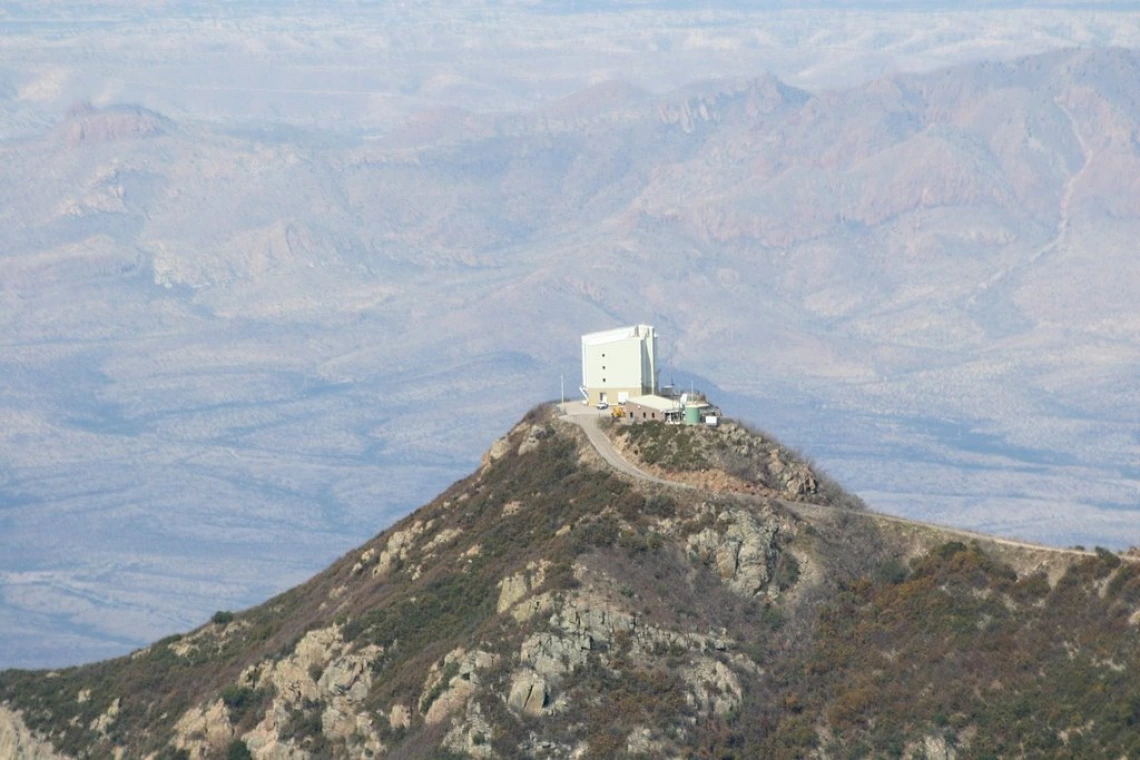
The MMT Observatory, formerly known as the Multiple Mirror Telescope, sits atop Mount Hopkins in the Santa Rita Mountains south of Tucson. The telescope, which is jointly managed by the UA and the Smithsonian Institution, turns 40 this month. (Photo courtesy of Frank Taylor)
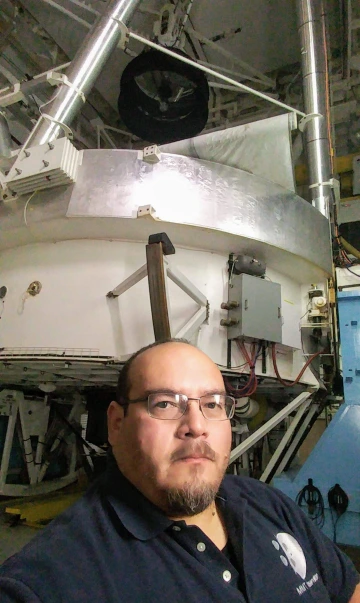
Mike Alegria, the MMT's assistant operations manager, commutes 1 1/2 hours to his office in the observatory.
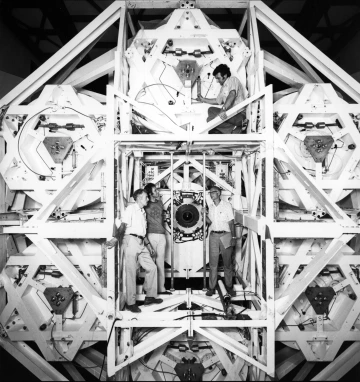
The Multiple Mirror Telescope 40 years ago as seen from the back. Standing at the center of the telescope are (from left) Nathaniel Carleton of the Smithsonian Astrophysical Laboratory, Neville "Nick" Woolf, professor emeritus in Steward Observatory, who was acting director of the MMT Observatory at the time, and William Hoffman, professor emeritus in Steward Observatory. J.T. Williams, the former MMT site manager and now the observatory's technical expert, is above.
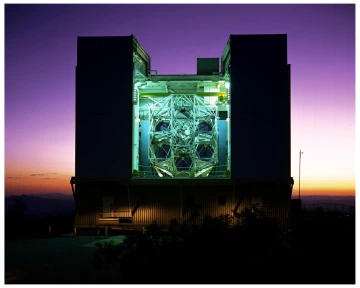
The MMT's original design featured six mirrors, arranged in a configuration that resembled the cylinder of a six-shooter. (Photo: Howard Lester/MMTO)
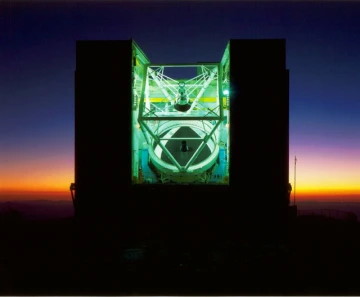
The six separate mirrors were replaced by a single mirror, about 21 feet in diameter, which was casted at the UA's Richard F. Caris Mirror Lab in 1992. (Photo: Howard Lester/MMTO)
When Mike Alegria begins his daily commute to work, what lies ahead are 1 1/2 hours of driving, including 6,000 feet of elevation gain and 24 switchbacks on a dirt road.
Perched atop a rocky ridge jutting out from a flank of Mount Hopkins in the Santa Rita Mountains south of Tucson, Alegria's office is tucked inside a metal box four stories tall, turning on four large steel wheels and surrounded by precarious drop-offs into the juniper-dotted high mountain desert landscape.
This month, that metal box – the MMT Observatory, formerly known as the Multiple Mirror Telescope – turns 40. The milestone marks a period of discovery and technological innovation driven by dedicated men and women who pushed the envelope of what was deemed possible.
"I've tightened every nut and screw on this telescope," says Alegria, who is MMT's assistant operations manager. Alegria has made the daily trek up the mountain since he was hired as an engineering aide in 1998 while studying engineering at Pima Community College.
"Every day is different up here, because the type of science we do is really varied," he added. "At one point, we used 13 different instrument configurations over the course of one year."
Jointly managed by the University of Arizona and the Smithsonian Institution, the MMT is the third-largest telescope in the continental U.S., after the Hobby-Eberly Telescope, managed by the University of Texas at Austin, and the Large Binocular Telescope, managed by the UA. With its original configuration of six mirrors grouped together in a configuration resembling the cylinder of a six-shooter, the MMT concept itself was the only of its kind, at least among larger telescopes, and informed the design of today's most advanced telescope designs, such as the LBT and the Giant Magellan Telescope, for which the UA is currently producing the primary mirror segments in the Richard F. Caris Mirror Laboratory.
"In the late 1970s, when the MMT was built, observatories consisted of massive, solid mirrors housed in huge buildings," says Grant Williams, who has been director of the MMT since 2011. The MMT, on the other hand, used mirrors originally designed to be light enough so they could be flown in space. And unlike typical observatory domes, which had to be large enough to accommodate a telescope turning inside, the MMT's housing was designed to rotate with the telescope – "like a gun turret on a battleship," according to Williams.
MMT's design originated in the late 1960s, when Frank Low of the UA Lunar and Planetary Laboratory discussed the idea of bundling together several small telescopes into one with Aden Meinel, founding director of the UA Optical Sciences Center (now the James C. Wyant College of Optical Sciences). Around the same time, Fred Whipple of the Smithsonian Astrophysical Observatory explored options for a "giant telescope" atop Mount Hopkins, and Meinel mentioned to him that he could obtain some surplus mirror blanks from the U.S. Air Force.
"The original MMT was a completely different approach to building a telescope," says Don McCarthy, who was a postdoctoral fellow at Steward Observatory when the MMT saw first light in 1979.
"Many thought the design was way too novel and it would never work," says McCarthy, who is now a University Distinguished Outreach Professor, astronomer and lecturer in Steward Observatory and the Department of Astronomy. "The MMT essentially consisted of six small telescopes with a combined 24 optical surfaces, and keeping all those surfaces aligned perfectly was a high-precision game."
To accomplish this, a complicated laser beam arrangement for the purpose of aligning the telescope was designed, and discarded, "once we realized you could use stars instead," according to McCarthy. Plus, moths kept flying through the laser beam, messing up the data.
"Here in Arizona, moths are a huge inconvenience for astronomers trying to observe," McCarthy says, "especially in the summertime. We are talking thousands of moths each night."
Observing in the visible and infrared light spectrum, the MMT is one of the most versatile telescopes available to astronomers.
"Because the telescope can be configured with one of three different secondary mirrors and has a versatile suite of instruments, the MMT can be used to study a wide range of astronomical targets for a broad set of scientific goals," Williams says, "from near-Earth objects, planets and moons in our own solar system to nearby stars and clusters, all the way to the most distant quasars and galaxies."
Even though the MMT's lightweight mirrors were replaced with one single mirror in 1999, they served as an early inspiration of the honeycomb design pioneered by Roger Angel, a Regents' Professor of Astronomy who directs the Caris Mirror Lab. Today, the UA produces mirrors spanning 27 feet in diameter, and light enough to float in water.
An Inspiration for Today's (and Tomorrow's) Most Advanced Telescopes
In addition to being lighter and less costly to manufacture than solid mirrors, hollow mirrors adjust to the ambient temperature much more quickly, which helps astronomers combat their biggest enemy: air turbulence, or the tiny fluctuations in the atmosphere that make stars twinkle.
"It was a very innovative time, and the lessons learned by that combination of brilliant, innovative and creative people who worked great together laid the foundation for the MMT to become the blueprint for what you see in most modern telescopes," McCarthy says.
In an effort to increase the telescope's light-gathering power so astronomers could observe fainter, farther targets more efficiently, the multiple-mirror design gave way to a single primary mirror cast at the Mirror Lab in 1992. Measuring 6.5 meters – or about 21 feet – in diameter, the new mirror was the largest mirror that had ever been cast at the time.
At the same time, the MMT was fitted with an adaptive secondary mirror. Just over 2 feet in diameter and less than .08 of an inch thin – about the thickness of a quarter – this mirror resembles a "huge contact lens" as Williams puts it, and changes its shape 500 times a second to compensate for air turbulence – another breakthrough that allows astronomers to obtain images from the ground that until then were deemed the domain of space telescopes.
The MMT has aided astronomers in some of the most important discoveries about the cosmos. One of the most highly cited papers solved the long-standing mystery of gamma ray bursts. Lasting a few seconds to minutes at most, these pulses of intense gamma rays flare up from the depths of space and tell of events almost beyond comprehension. Observations with the MMT revealed that they are caused either when a massive star collapses at the end of its life and explodes into a supernova, with some turning into a black hole, or when such a stellar remnant merges with another black hole. Another reported the first direct imaging of planets forming in a star system 129 light-years away from Earth.
During a special science symposium hosted by Steward Observatory this month, astronomers will discuss how to best put the MMT's strengths to use to advance the field. Alegria is convinced that, thanks to the MMT, students and scientists at the UA and the Smithsonian Institution will remain at the cutting edge of astronomy.
About two dozen employees work for the MMT, either as "town folk," the staff housed in the MMT offices at Steward Observatory, or as the support staff on Mount Hopkins.
"We always have a telescope operator on site, and in recent years, we've also had a queue observer on site," says Alegria, himself a former telescope operator. "Eighty percent or more of our observing is now being done in queue mode, which means the astronomers don't have to come to the telescope to make their observations. They submit their requests, and the queue observer on site does the observations for them."
Raising the Glass
During the daytime, seven people tend to the telescope facilities, and there always is something to do, Alegria says. The night operators work seven nights in a row, and they stay up on the mountain for that whole week. Then they're off for two weeks.
"The telescope itself is so complicated that we train new people for one year before we let them operate it by themselves," Alegria says. "In addition to controlling all its instruments and systems, you spend all night watching the weather. You need to know what the clouds are doing, and what the wind is doing. The wind wants to blow that 6.5-meter mirror around; it's like a large sail. You become really good at forecasting."
On a slow night, the operator takes long exposures of five or six objects, he says. On a busy night, it's hundreds.
"Some nights it can be difficult to go to the bathroom. It can be quite hectic, and it can be very slow. It depends on what instrument package is on and what kind of science they want to do."
At the end of the workday, before climbing into his truck and heading down the mountain, Alegria and his colleagues "raise the glass" – telescope operator lingo for lifting the primary mirror into observing position – with 104 pneumatic actuators.
"Then they touch base with the night operators to update them about what we did during the day," he says. "And then we're off for the night."
And as the day crew retires from an exhausting day, the telescope awakens.
To mark the observatory's 40th anniversary, McCarthy will present a public lecture titled "Still Innovating and Discovering! – The MMT Turns 40" on Monday at 7:30 p.m. in Steward Observatory, Room N210. Leaders of the MMT Observatory will also hold a three-day symposium from May 14-16 in Environment and Natural Resources 2, Room S107. For more information, visit the MMT Observatory website.
The website also includes more details about the history of the telescope and information about public tours.

